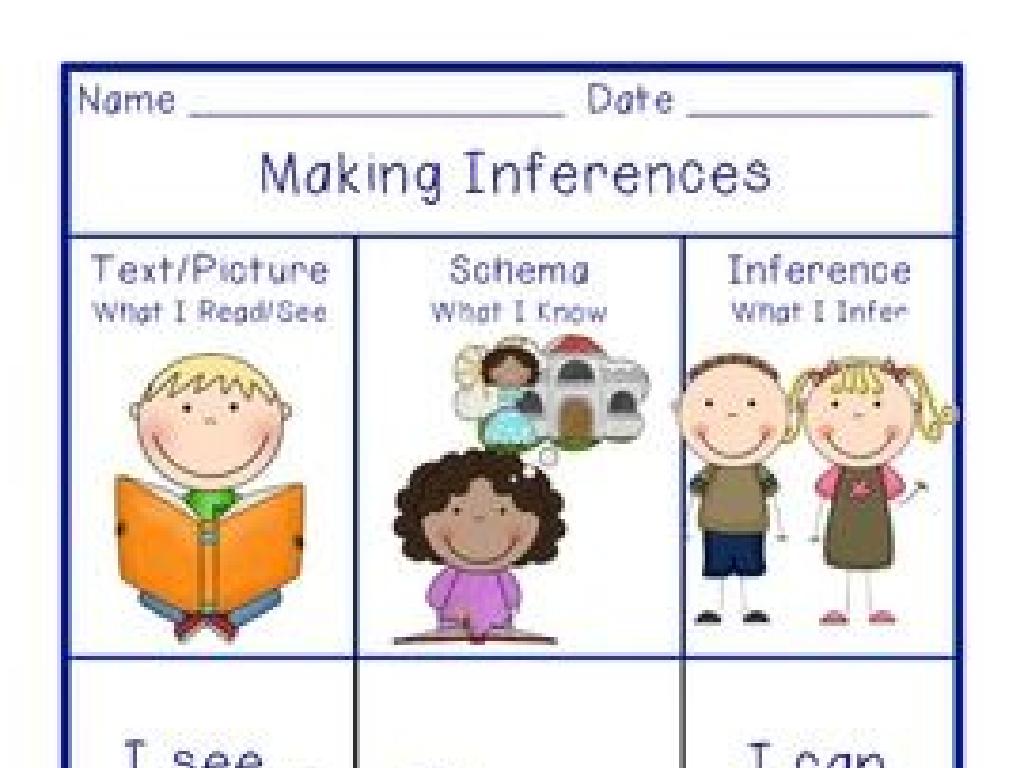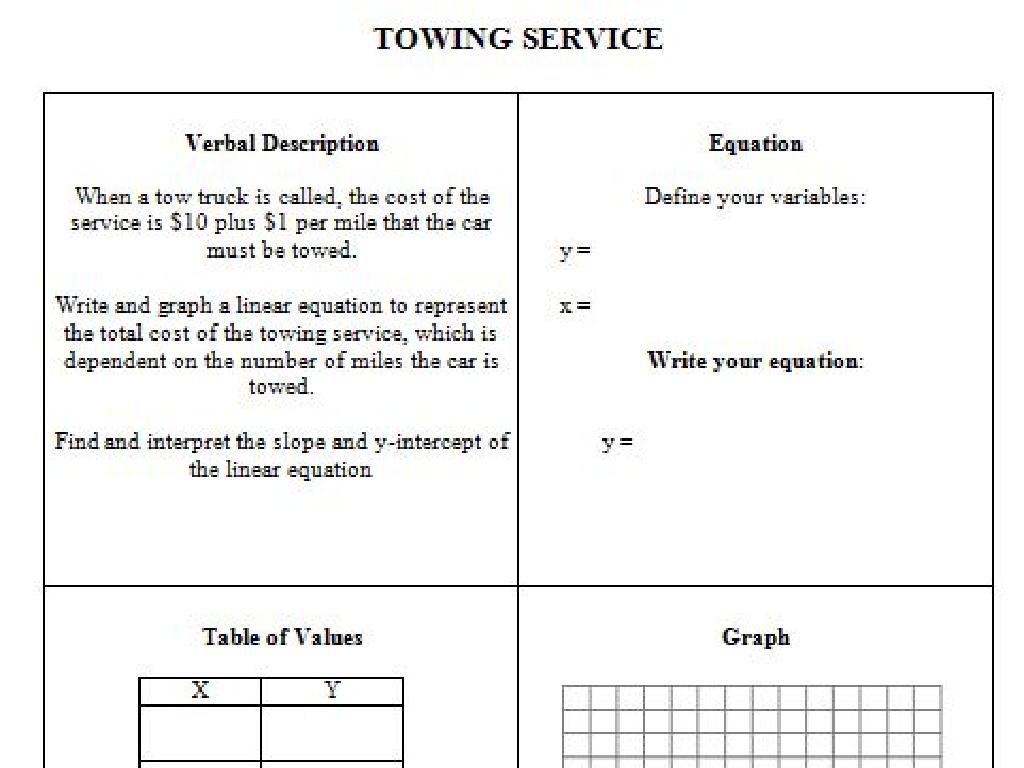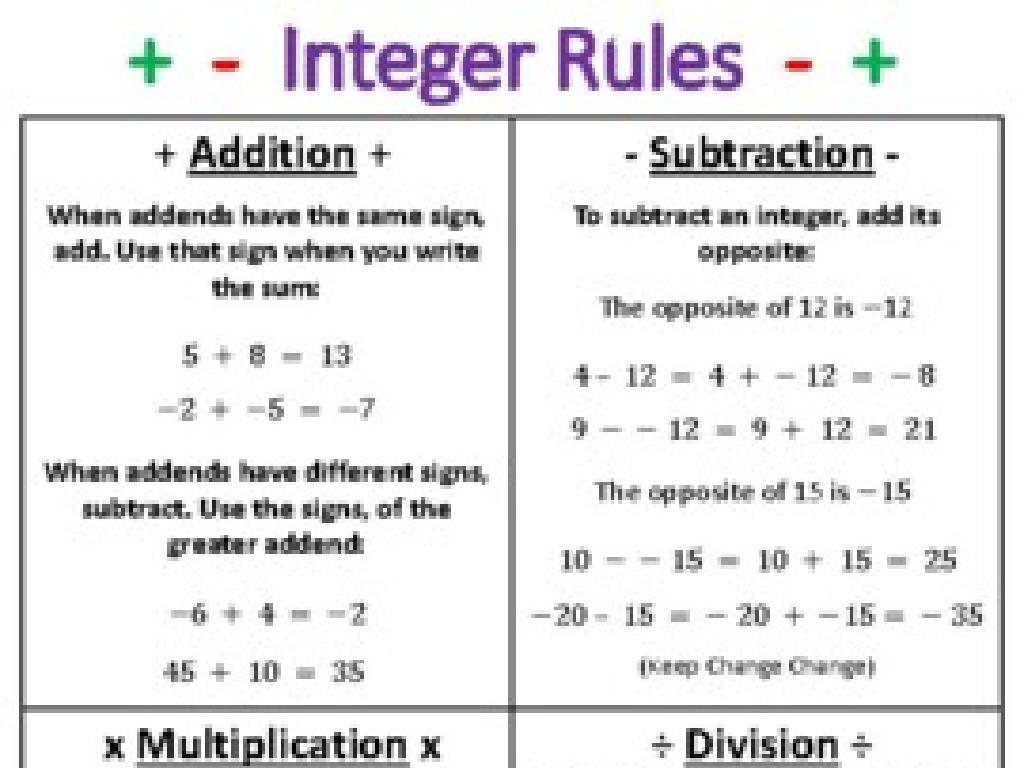Conversion Tables - Customary Units
Subject: Math
Grade: Fifth grade
Topic: Customary Units Of Measurement
Please LOG IN to download the presentation. Access is available to registered users only.
View More Content
Welcome to Customary Units!
– Understanding customary units
– Units like inches, feet, yards, and miles for length
– Importance of measurement
– To accurately describe and compare objects and distances
– Everyday measurement examples
– Measuring your height, or the length of a book
– Practice with real objects
– Use a ruler to measure pencils, or a tape measure for room dimensions
|
This slide introduces students to the concept of customary units of measurement, which are used primarily in the United States. Start by explaining what customary units are and the common units for measuring length, capacity, and weight. Discuss the necessity of having standard measurements in everyday life, such as cooking, building, and buying goods. Provide relatable examples that students encounter daily. Encourage students to bring items from home to measure in class, fostering a hands-on understanding of how these units are applied. This activity will help solidify their grasp of measurement concepts and the practical use of customary units.
Understanding Customary Units
– What are customary units?
– System of measurement used in the U.S.
– Common customary units
– Inches, feet, yards, miles, ounces, pounds, cups, pints, quarts, gallons
– Brief history of customary units
– Originated from English units used in Middle Ages
– Importance in everyday life
|
This slide introduces students to the concept of customary units, which are the main system of measurement used in the United States. It’s important to familiarize students with the common units such as inches, feet, yards, miles for length; ounces and pounds for weight; and cups, pints, quarts, and gallons for volume. Provide a brief history of how these units came into use, originating from the English units that were standardized in the Middle Ages. Emphasize the relevance of understanding and using these units in everyday life, such as in cooking, measuring distances, and weighing objects. Encourage students to think of examples where they have encountered these units outside of school.
Length Conversion: Customary Units
– Converting inches, feet, yards, miles
– Use a table to change one unit to another
– Example conversions
– 12 inches = 1 foot, 3 feet = 1 yard
– Practice: 24 inches to feet
– How many feet are in 24 inches?
|
This slide introduces students to the concept of length conversion within the customary units of measurement. Start by explaining the basic units of inches, feet, yards, and miles, and how they relate to each other. Use the provided examples to show these relationships in a tangible way. For the practice problem, guide students through the process of converting 24 inches to feet by dividing by the number of inches in a foot. This exercise will help solidify their understanding of the conversion process. Encourage students to set up the division and solve the problem, reinforcing the concept that 12 inches make up 1 foot.
Volume Conversion: Cups, Pints, Quarts, Gallons
– Converting between units
– Standard volume conversions
– 2 cups = 1 pint, 4 quarts = 1 gallon
– Example conversions
– 2 cups make a pint, like 2 scoops of ice cream make a double scoop!
– Practice: 8 cups to quarts
– How many quarts are in 8 cups? Hint: Use the conversions!
|
This slide introduces students to the concept of volume conversion within the customary units of measurement. Start by explaining that different tasks require different units of measurement, and being able to convert between these units is a valuable skill. Use everyday examples to make the conversions relatable, such as how many cups of water are needed to fill a gallon jug. After presenting the standard conversions, walk through the example conversions to solidify understanding. Finally, present the practice problem and guide students through the process of converting 8 cups to quarts, reinforcing the conversion relationship between cups and quarts. Encourage students to visualize the quantities as they work through the problem.
Weight Conversion: Ounces to Pounds
– Understanding ounces and pounds
– 16 ounces equals 1 pound
– Common reference for weight measurement
– Converting ounces to pounds
– Divide the number of ounces by 16 to find pounds
– Practice: 32 ounces to pounds
– How many pounds are in 32 ounces?
|
This slide introduces students to the concept of weight conversion between ounces and pounds, which are customary units of measurement in the United States. Start by explaining that ounces (oz) and pounds (lb) are used to measure weight, with one pound being equivalent to 16 ounces. Use everyday examples to illustrate the concept, such as a pound of fruits or a bag of coffee. Then, guide students through the process of converting ounces to pounds by dividing the number of ounces by 16. For the practice problem, students will apply this knowledge to convert 32 ounces to pounds, reinforcing their understanding of the conversion method. Encourage students to solve the problem on their own before discussing the solution as a class.
Mastering Conversion Tables
– Importance of conversion tables
They help us compare and convert measurements in recipes, construction, and more.
– Effective use of conversion tables
Always double-check your work and understand the relationship between units.
– Class interactive conversion activity
Let’s convert cups to pints and inches to feet together as a class!
– Practice makes perfect
|
Conversion tables are essential tools in various real-life situations, such as cooking, where we often need to convert measurements from one unit to another. To use these tables effectively, students should be taught to carefully check the units they are converting to and from, and to always verify their answers. During the class activity, guide the students through a series of conversions, such as cups to pints or inches to feet, to help them understand the process. Encourage participation and provide immediate feedback. As homework, assign a few conversion exercises for practice to reinforce the day’s lesson.
Real-life Applications of Customary Units
– Customary units in daily life
– Used in cooking, building, etc.
– Conversions aid in tasks
– Helps compare, adjust quantities
– Example: Recipe measurement conversions
– Changing cups to tablespoons for precision
– Understanding units enhances accuracy
|
This slide aims to show students the practical use of customary units in everyday activities such as cooking and building. Emphasize how understanding and being able to convert between these units can be very helpful. For instance, when doubling a recipe, knowing how to convert measurements ensures the dish turns out as intended. Discuss the importance of precision in building to ensure structures are stable and safe. Encourage students to think of other areas where they might need to use customary units and conversions. Provide additional examples, such as converting inches to feet when measuring height or yards to feet when buying fabric.
Class Activity: Conversion Relay!
– Teams solve conversion problems
– Each team tackles a series
– First to finish correctly wins
– Celebrate teamwork and accuracy
|
Divide the class into small teams, ensuring a mix of abilities in each group. Provide each team with a series of conversion problems involving customary units (e.g., inches to feet, ounces to pounds). The problems should be of increasing difficulty. The first team to correctly complete their set of conversions will be declared the winner. Emphasize the importance of accuracy over speed to avoid careless mistakes. Possible variations of the activity could include a relay race where students take turns solving problems, a scavenger hunt with conversion clues, or a ‘Jeopardy’-style game with conversion categories. This activity aims to reinforce the students’ understanding of customary units and their ability to perform conversions while fostering a spirit of collaboration and friendly competition.
Wrapping Up: Customary Units
– Recap today’s lesson
– We reviewed length, weight, and volume in customary units.
– Practice is key to mastery
– Regular practice helps solidify understanding of conversions.
– Homework: Conversion worksheet
– Apply what you’ve learned to complete the worksheet for next class.
|
As we conclude today’s lesson on customary units, it’s important to review the key concepts we’ve covered, including the units for measuring length (inches, feet, yards, miles), weight (ounces, pounds, tons), and volume (cups, pints, quarts, gallons). Emphasize the importance of practice in mastering these concepts, as familiarity with conversion is essential in many real-life situations. For homework, students are assigned a worksheet that includes a variety of conversion problems to reinforce their learning. Encourage them to attempt all problems and remind them that these skills are building blocks for more advanced math concepts. Be available for any questions during the next class.






